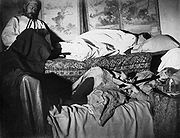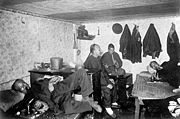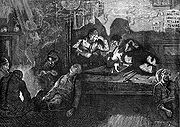
Opium den
Encyclopedia

Opium
Opium is the dried latex obtained from the opium poppy . Opium contains up to 12% morphine, an alkaloid, which is frequently processed chemically to produce heroin for the illegal drug trade. The latex also includes codeine and non-narcotic alkaloids such as papaverine, thebaine and noscapine...
was sold and smoked. Opium dens were prevalent in many parts of the world in the 19th century, most notably China
China
Chinese civilization may refer to:* China for more general discussion of the country.* Chinese culture* Greater China, the transnational community of ethnic Chinese.* History of China* Sinosphere, the area historically affected by Chinese culture...
, Southeast Asia
Southeast Asia
Southeast Asia, South-East Asia, South East Asia or Southeastern Asia is a subregion of Asia, consisting of the countries that are geographically south of China, east of India, west of New Guinea and north of Australia. The region lies on the intersection of geological plates, with heavy seismic...
, North America
North America
North America is a continent wholly within the Northern Hemisphere and almost wholly within the Western Hemisphere. It is also considered a northern subcontinent of the Americas...
and France
France
The French Republic , The French Republic , The French Republic , (commonly known as France , is a unitary semi-presidential republic in Western Europe with several overseas territories and islands located on other continents and in the Indian, Pacific, and Atlantic oceans. Metropolitan France...
. Throughout the West
Western world
The Western world, also known as the West and the Occident , is a term referring to the countries of Western Europe , the countries of the Americas, as well all countries of Northern and Central Europe, Australia and New Zealand...
, opium dens were frequented by and associated with the Chinese, because the establishments were usually run by Chinese
Chinese people
The term Chinese people may refer to any of the following:*People with Han Chinese ethnicity ....
who supplied the opium as well as prepared it for visiting non-Chinese smokers. Most opium dens kept a supply of opium paraphernalia such as the specialized pipes and lamps that were necessary to smoke the drug. Patrons would recline in order to hold the long opium pipe
Opium pipe
An opium pipe is a pipe designed for the vaporization and inhalation of opium. True opium pipes allow for the drug to be vaporized while being heated over a special oil lamp known as an opium lamp. It is thought that this manner of "smoking" opium began in the seventeenth century when a special...
s over oil lamp
Opium lamp
An opium lamp is an oil lamp designed specifically to facilitate the vaporization and inhalation of opium. Opium lamps differ from conventional lamps for lighting in that they are designed to channel an exact amount of heat upward through their funnel-shaped chimneys...
s that would heat the drug until it vaporized, allowing the smoker to inhale the vapors. Opium dens in China were frequented by all levels of society, and their opulence or simplicity reflected the financial means of the patrons. In urban areas of the United States
United States
The United States of America is a federal constitutional republic comprising fifty states and a federal district...
, particularly on the West Coast
West Coast of the United States
West Coast or Pacific Coast are terms for the westernmost coastal states of the United States. The term most often refers to the states of California, Oregon, and Washington. Although not part of the contiguous United States, Alaska and Hawaii do border the Pacific Ocean but can't be included in...
, there were opium dens that mirrored the best to be found in China, with luxurious trappings and female attendants. For the working class
Working class
Working class is a term used in the social sciences and in ordinary conversation to describe those employed in lower tier jobs , often extending to those in unemployment or otherwise possessing below-average incomes...
, there were also many low-end dens with sparse furnishings. These latter dens were more likely to admit non-Chinese smokers.
San Francisco

California Gold Rush
The California Gold Rush began on January 24, 1848, when gold was found by James W. Marshall at Sutter's Mill in Coloma, California. The first to hear confirmed information of the gold rush were the people in Oregon, the Sandwich Islands , and Latin America, who were the first to start flocking to...
. The jumping-off point for the gold
Gold
Gold is a chemical element with the symbol Au and an atomic number of 79. Gold is a dense, soft, shiny, malleable and ductile metal. Pure gold has a bright yellow color and luster traditionally considered attractive, which it maintains without oxidizing in air or water. Chemically, gold is a...
fields was San Francisco, and the city's Chinatown became the site of numerous opium dens soon after the first Chinese arrived around 1850. By the 1870s, San Francisco's opium dens attracted non-Chinese residents, and the problem of opium addiction was acknowledged by the city at large. In 1878, the city of San Francisco passed its first anti-opium ordinance. In the early 20th century, huge bonfires, fueled by confiscated opium and opium paraphernalia, were used to destroy opium and create a public venue to discuss opium use. Due to opium-eradication campaigns, smoking opium was driven underground and was still fairly common in San Francisco and other cities in North America until around World War II
World War II
World War II, or the Second World War , was a global conflict lasting from 1939 to 1945, involving most of the world's nations—including all of the great powers—eventually forming two opposing military alliances: the Allies and the Axis...
. A typical opium den in San Francisco might be a Chinese-run laundry that had a basement, back room, or upstairs room that was tightly sealed to keep drafts from making the opium lamp
Opium lamp
An opium lamp is an oil lamp designed specifically to facilitate the vaporization and inhalation of opium. Opium lamps differ from conventional lamps for lighting in that they are designed to channel an exact amount of heat upward through their funnel-shaped chimneys...
s flicker or allowing the tell-tale fumes of opium escape. A photograph of one luxurious opium den in 19th-century San Francisco has survived, taken by I. W. Taber
I. W. Taber
Isaiah West Taber was an American daguerreotypist, ambrotypist, and photographer who took many pictures of noted Californians, which he donated to the California State Library "that the state may preserve the names and faces, and keep alive the memory of those who made it what it is." He was also...
in 1886, but the majority of the city's wealthy opium smokers, both Chinese and American, shunned public opium dens in favor of smoking in the privacy of their own homes.
New York
The opium dens of New York CityNew York City
New York is the most populous city in the United States and the center of the New York Metropolitan Area, one of the most populous metropolitan areas in the world. New York exerts a significant impact upon global commerce, finance, media, art, fashion, research, technology, education, and...
's Chinatown
Chinatown, Manhattan
Manhattan's Chinatown , home to one of the highest concentrations of Chinese people in the Western hemisphere, is located in the borough of Manhattan in New York City...
, due to its geographical distance from China, were not as opulent as some of those to be found on the American West Coast. According to H. H. Kane, a doctor who spent years studying opium use in New York in the 1870s and 1880s, the most popular opium dens (or "opium joints" as they were known in the parlance of the day) were located on Mott and Pell streets in what is still Manhattan
Manhattan
Manhattan is the oldest and the most densely populated of the five boroughs of New York City. Located primarily on the island of Manhattan at the mouth of the Hudson River, the boundaries of the borough are identical to those of New York County, an original county of the state of New York...
's Chinatown. At the time, all the city's opium dens were run by Chinese, except for one on 23rd Street
23rd Street (Manhattan)
23rd Street is a broad thoroughfare in the New York City borough of Manhattan. It is one of few two-way streets in the gridiron of the borough. As with Manhattan's other "crosstown" streets, it is divided at Fifth Avenue, in this case at Madison Square Park, into its east and west sections. Since...
that was run by an American woman and her two daughters. Kane remarked that New York's opium dens were one place "where all nationalities seem indiscriminately mixed". As in San Francisco, New Yorkers of all races would come to Chinatown to patronize its opium dens. New York City's last opium den was raided and shut down on June 28, 1957.
Canada
Chinese immigrants first established ChinatownChinatown
A Chinatown is an ethnic enclave of overseas Chinese people, although it is often generalized to include various Southeast Asian people. Chinatowns exist throughout the world, including East Asia, Southeast Asia, the Americas, Australasia, and Europe. Binondo's Chinatown located in Manila,...
s in Victoria
Chinatown, Victoria
The Chinatown in Victoria, British Columbia is the oldest in Canada and second in age only to San Francisco's in North America, with its beginnings in the mass influx of miners from California to what is now British Columbia in 1858. Its history goes back to the mid nineteenth century. It remains...
and Vancouver in British Columbia
British Columbia
British Columbia is the westernmost of Canada's provinces and is known for its natural beauty, as reflected in its Latin motto, Splendor sine occasu . Its name was chosen by Queen Victoria in 1858...
, and here too, opium dens were common in the late 19th and early 20th centuries. When the city of San Francisco began taxing imported opium for smoking, the trade was diverted to Victoria
Victoria, British Columbia
Victoria is the capital city of British Columbia, Canada and is located on the southern tip of Vancouver Island off Canada's Pacific coast. The city has a population of about 78,000 within the metropolitan area of Greater Victoria, which has a population of 360,063, the 15th most populous Canadian...
, and, from there, much of the opium was smuggled south into the United States. However, a fair amount of opium was consumed in the opium dens to be found in the Chinatowns of Victoria and Vancouver
Vancouver
Vancouver is a coastal seaport city on the mainland of British Columbia, Canada. It is the hub of Greater Vancouver, which, with over 2.3 million residents, is the third most populous metropolitan area in the country,...
. The latter city's "Shanghai Alley" was known for its rustic opium dens. As in the United States, non-Chinese often frequented the Chinese-run opium dens in Canadian
Canada
Canada is a North American country consisting of ten provinces and three territories. Located in the northern part of the continent, it extends from the Atlantic Ocean in the east to the Pacific Ocean in the west, and northward into the Arctic Ocean...
Chinatowns.
France
Unlike the opium-smoking scene in North American cities, opium smoking in FranceFrance
The French Republic , The French Republic , The French Republic , (commonly known as France , is a unitary semi-presidential republic in Western Europe with several overseas territories and islands located on other continents and in the Indian, Pacific, and Atlantic oceans. Metropolitan France...
was introduced for the most part by French expatriates returning home from stints in their Indochinese colonies
French colonial empire
The French colonial empire was the set of territories outside Europe that were under French rule primarily from the 17th century to the late 1960s. In the 19th and 20th centuries, the colonial empire of France was the second-largest in the world behind the British Empire. The French colonial empire...
. By the early 20th century, there were numerous opium dens in France's port cities, particularly Toulon
Toulon
Toulon is a town in southern France and a large military harbor on the Mediterranean coast, with a major French naval base. Located in the Provence-Alpes-Côte-d'Azur region, Toulon is the capital of the Var department in the former province of Provence....
, Marseille
Marseille
Marseille , known in antiquity as Massalia , is the second largest city in France, after Paris, with a population of 852,395 within its administrative limits on a land area of . The urban area of Marseille extends beyond the city limits with a population of over 1,420,000 on an area of...
and Hyères
Hyères
Hyères , Provençal Occitan: Ieras in classical norm or Iero in Mistralian norm) is a commune in the Var department in the Provence-Alpes-Côte d'Azur region in southeastern France....
.
London

External links
- Opium Museum
- Opium in the French Navy
- Limehouse debunked
- San Francisco Opium Den Photos circa 1889
- Scenes From an Opium Den - slideshow by Life magazine

